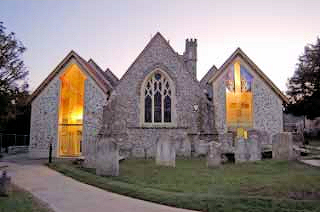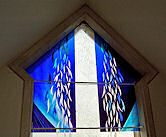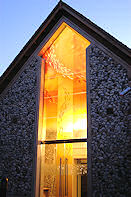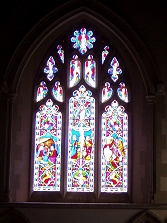
by NA Rogers-Davis
The majority of the stained glass in St Margaret's is 19th Century. The exceptions to this are a panel intalled in the 1930s (which might be as early as the 16th Century) and the new windows/doors installed in the new east facing buildings in 2009 as part of the 2008/9 "re-ordering".
Catholic revival in England in the 19th century and the restoration of many C of E churches at that time brought about a renewed demand for stained glass windows and a revival in the art of its making. With the rebuilding of St Margaret's in 1853, its architect SS Teulon may have been influenced by this revival and have encouraged the use of stained glass.
It is known that Teulon introduced 7 stained glass windows in the 1853 rebuilding. All of these came from the family firm of Gibbs & Co. A further 5 stained glass windows, installed between 1868 and 1888 are attributed to Lavers, Barraud & Westlake Ltd. The 3-compartment window at the west of the tower, donated by George Olliver of Kingston, and the windows in the south side of the chancel may have been installed before 1853 but both were made by Ward & Nixon.
Alexander Gibbs started making stained glass windows in 1848 in his Bloomsbury/Bedford Square workshops. His work is typified by gentle-faced figures in gaudy clothes of rather discordant colour but fairly ornate with colourful detail. Gibbs' windows in St Margaret's are located in the Chancel, the Gratwicke Chapel, and the westernmost window in the north wall (depicting The Last Supper). Gibbs manufactured windows for many churches across Sussex, predominantly in the north and east of the county but, near home, for St Nicholas, Arundel, and St Mary & St Blaise, Boxgrove.
Ward & Nixon was a partnership between Thomas Ward (1808-70) and James Henry Nixon (1802-57). Their studio was at 67 Frith Street, Soho, London
Lavers, Barraud, and Westlake Ltd, of Endell Street in London was one of the leading studios of High Gothic Revival glass. The firm made extensive use of large segments of irregularly "flashed" glass in robes and draperies. Their work can be seen in the windows in the south and west walls of the church and in the porch. Nathaniel Lavers (1828-1911) and Philip Barraud (1824-1900) started their own company in 1858 having earlier worked for James Powell & Sons, probably better known for their renowned Whitefriars stained glass. Lavers and Barraud took the artist Nathaniel Westlake into their partnership 10 years later. The company was a prolific designer and maker of church windows and are known to have made more than 40 alone for Sussex churches. Apart from Angmering, these included the parish churches of Ferring, Findon, West Tarring, and Washington.
It has been suggested that a sixth window was manufactured by Lavers, Barraud, and Westlake Ltd, i.e. the Horton window in the north wall, but this cannot be correct as the firm ceased operating in 1921 and the Horton window was not installed until 1933. But this information may also be suspect if the window is significatly older (possibly as early as 16th century) as is believed. This window is of particular interest as a faculty allowed for the central stone mullion of the window to be removed to allow the installation of a square stained glass panel.
Below are details of the stained glass windows in St
Margaret's and their inscriptions. Where a photo is included, clicking on
the top half of this photo will bring up a larger and more detailed version of
the specific window.
EAST FACE 
Window & Door in Welcoming Building and Window in Office Building
Designer-Maker: Designed and created by Mel Howse at Derix Glass Studios, Taunusstein, Germany
Installation Date: 2009
This contemporary glass was installed in 2009 during the re-ordering of St Margaret's when the new buildings were constructed at the east end of the church, on either side of the Chancel.
The windows feature symbolic etched and enamelled
glass.The warm yellow and gold glasswork of the entrance
facade represents a welcome from St Margaret's to all that visit. An ethereal
image of The Holy Spirit is depicted in the sweeping motion of the layered
motifs which echo the church's original architecture and tracery. Similarly,
the blue and white glasswork of the new office's fenestration is also rich in
imagery.

The arrow-shaped windows are symbolic and point to the "traditional heavenly location" above.
In the top photo (not enlargeable) taken of the
east of the church at twilight, the glass is backlit as is the photo of the new
entrance on the bottom left. The photo on the bottom right is taken from the
inside of the office with natural coming from outside.
(photos: ©
Ray Whitehouse, 2009)
.
For more photos of the glass in St Margaret's, visit Mel Howse's website by clicking here.
East window – three compartments
Maker: Gibbs & Co
Installation Date: 1853 1
Given by: WGK Gratwicke
Within the top tracery is a representation of Christ ascending into Glory and the apostles “gazing up” with wonder and adoration into heaven (Acts 1/11)
Below the tracery in the Left or Northern Compartment is Abraham purchasing from Ephron the Hittite, the cave at Machpelah, for a burial place for Sarah, and in the act of weighing the 400 shekels of silver, the price paid for the purchase. (Genesis 23/16-18)
Label has a text from the same chapter...“I am a stranger and a sojourner with you. Give me a possession of a burial place with you” (Genesis 23/4)
The Centre Compartment of the East Chapel window represents the aged Isaac, “Whose eyes were dim, so that he could not see”, blessing Jacob.
Label By faith Isaac blessed “Jacob and Esau” concerning things to come (Heb 11/20)
In the Right or Southern Compartment is Israel blessing the two sons of Joseph, Ephraim and Manesseh (Genesis 48.)
Label “By faith” Jacob when he was dying, blessed both the sons of Joseph. (Heb. 11/21)
South windows
Maker: Gibbs & Co
Installation Date: 1853 1
Given by: WGK Gratwicke
Easternmost window - the raising to life the son of the widow of Nain.
Label “And he said., Young
man, I say unto thee, Arise. (Luke 7/14)
EX-GRATWICKE CHAPEL AREA
South windows
Maker: Gibbs & Co
Installation Date: 1853 1
Given by: WGK Gratwicke
Westernmost window - the raising of Lazarus.
Label - "I am the resurrection and the life – Loose him and let him go." (John 11/25 and 44)
THE CHANCEL
East Window
Maker: Gibbs & Co
Installation Date: 1853 1
Given by: WGK Gratwicke
 The Tracery in the
upper part of this window is filled with adoring angels holding different
musical instruments in their hands.
The Tracery in the
upper part of this window is filled with adoring angels holding different
musical instruments in their hands.
Below in the Left or Northern Compartment is a Representation of the Nativity. “Underneath the thatch of the stable, on the shed are Joseph and Mary and the infant Jesus, and above it is the ‘star’ which conducted the wise men from the East, and went before them till it came and stood over where the young child was". ( Matthew 2/9)
Label - " Great is the mystery of godliness. God was manifest in the flesh". ( I. Tim. 3/16)
The Centre Compartment contains the
“Crucifixion” and immediately over it St. Cecilia the Patroness of
Ecclesiastical Music, playing upon a Harmonico.
The Subject represents the
three Marys at the Cross, the Virgin on the left, and Mary Magdalene at the
foot of it. Now there stood by the cross of Jesus, his mother and his
mothers’ sister. Sister, Mary, the wife of Clopas and Mary
Magdalene. ( John 19/25)
Label - "Who, his own self bare “Our sins in his own body on the Tree”. ( I Peter. 2/24)
The Right or Southern Compartment contains the
“Resurrection” representing the two Marys at the Sepulchre and the
Angel pointing to it and saying “He is not here, for he is risen, as he
said “Come see the place where the Lord lay. ( Matthew
28/6). Below is the guard of soldiers, who were appointed to watch the
Sepulchre, asleep.
Label -“I am the
resurrection and the life, Saith the Lord.” ( John
11/25)
THE CHANCEL
Two-light window, on the North side
Maker: Gibbs & Co
Installation Date: 1853 1
Given by: Rev WH Reeks
The border of this window is composed of Passion flowers
and of lilies, the first being an emblem of our Lord, and the other of the
Virgin Mary.
The Easternmost Compartment shows the raising of
the daughter of Jairus, the ruler of the Synagogue.
Label - “Believe only, and she shall be most whole. (St. Luke 8/50)
In the Westernmost Compartment is the marriage of Cana of Galilee where Christ performed the miracle of turning water into wine.
Label - “Whatsoever he saith unto you, do it.” The words are of his mother as related by St. John 2/5
Note: The 1853 cost of this window was £32.
THE CHANCEL
Two-light window on the South side
Maker: Ward & Nixon 5
Installation Date: 1853 ?
Given by: Rev W (....?)
In the Easternmost Compartment is the woman of Canaan beseeching Christ to heal her daughter, who was grievously vexed with a devil.
Label - “Lord, help me.” (St. Matthew 15/25)
In the Westernmost Compartment is Christ resorting
to sight the man who was born blind.
Label -
“Go wash in the Pool of Siloam.” (St. John
9/7)
TOWER WINDOW
Installation Date: Unknown but probably first half of 19thC
Maker: Ward & Nixon 5
Given by: George Olliver (of Kingston)
This window contains in the Centre Compartment a
figure of St. Margaret to whom the church is dedicated bearing a scroll on
which is inscribed:-
“Cast all your care upon him for he careth
for you. ( I. Peter 5/7)
In the South or left hand Compartment at the top is an Angel, supposed to be instructing St. Matthew what to write and at the bottom is a Winged Lion Couchant, the emblem of St. Mark.
In the North or right Compartment at the top is a
Winged Ox, the emblem of St. Luke. It is represented in a state of
repose, chewing the cud, to denote a contemplative disposition. At the
borrow is an Eagle, the emblem of St. John in token of the mysterious grandeur
of his Revelations and the sublime flights of his guiles.
In the
centre of the North and South compartments are the “Alpha” and
“Omega” (I am the first and the last.) Encircled with blue.
SOUTH WALL
Westernmost Window
Maker: Lavers, Barraud & Westlake Ltd
Installation Date: 1868 2
In the L.H. compartment is the Agony in Gethsemene.
Label “Not my will but thine be
done”
In the R.H. compartment is Christ bearing the Cross.
Label “He hath borne our griefs and carried
our sorrows”
In memory of George Orme 1867
Easternmost Window
Maker: Lavers, Barraud & Westlake Ltd
Installation Date: 1872
In LH. Compartment is the Resurrection.
Label “Now is Christ risen from the
dead”
In R.H compartment is the Transfiguration.
Label “He was transfigured before
them”
In memory of William Orme 1872
Window repaired 2009
WEST WALL
West Wall (in South aisle)
Maker: Lavers, Barraud & Westlake Ltd
Installation Date: 1888
In the Tracery at the top are pictures of leaves
and fruit.
Left compartment - Mary of Bethany.
Centre compartment - St. John the Divine.
Right
compartment - St. Margaret.
Inscribed on brass plate below
“To the
glory of God and in memory of the best of mothers this window is erected by her
son Sir Henry Fletcher Bart. of Ham Manor, Angmering. Dame Emily Fletcher
died Jan. 30 1888”
PORCH
Maker: Believed to be Lavers, Barraud & Westlake Ltd
Given by: Lady Agnes Aubrey Fletcher
Installation Date: c1870
Presentation in Temple, St. Cecelia
St. Cecelia
by Lady Aubrey Fletcher, gift in memory of her brother Charles Wilson, Royal
Artillery
Marked ‘A.W. Jan. 9 1870’
On Eastern side
Maker: Lavers, Barraud & Westlake Ltd
Installation Date: c1870
Left hand Compartment -
Mary and infant Jesus
Right hand Compartment -
Figure of Christ
Marked ‘Lavers, Barraud &
Westlake London 1870’
Brass plate under window inscribed “In memory of Amy Pardoe 13 Jan. 1872 – 13 Jan. 1963 whose joy it was each week to beautify this porch with flowers”. This memorial plaque may not have any connection to the window which was installed 93 years beforehand.
NORTH WALL
First Window at Western end
Maker: Gibbs & Co
Installation Date: 1853 1
The tracery in the upper part of this window is filled with flowers and leaves.
The main compartment depicts the Lord’s Supper
Label. “He took bread and brake it and gave it to them and said take eat this is my body”.
NORTH WALL
Third window from Western end
Maker: Unknown
Artist: Unknown
Designer: Wilfred Drake
Installation Date: 1933
This window consists of a rectangular stained glass centre panel in a plain glass surround with geometrical panes designed by Wilfred Drake. The central stone mullion of the window has been removed to accommodate the square panel.
The panel depicts the Adoration of the Magi, and contains the inscription “In loving memory of Lottie Gray Horton. Given by her husband William S. Horton and Capt. Gray Horton MC (Scots Guards) her son 1933”
William Samual Horton and his wife, Lottie, both American citizens, are buried in St Margaret's churchyard. William was a well-known impressionist artist and friend of Monet and Degas.
The panel is reputed to be old and a PCC Minute of 7 June 1933 recorded "The Rector submitted a plan for a 16th century [sic] glass window to be installed in the middle window of the North Aisle in memory of the late Mrs Horton. It was decided unananimously on the proposition of Mr Andrews seconded by Mr Pyle. That the Council approves of the design for the memorial window to the late Mrs Horton as submitted to their meeting on 7th June 1933, and further that the Council supports the application for a Faculty for the installation of the same in the central window of the North Aisle" 3 .
It is felt that the PCC must have genuinely believed that the glass was an antiquity to have permitted the cental mullion to be removed to allow its installation. The overall window was designed by Wilfred Drake but it is possible that the stained glass panel may have come from a church or cathedral in France severely damaged or destroyed during WW1.
The window was dedicated by the Bishop of Chichester at a Sunday evening service on 3 December 1933 4.
read article on history of this window
I would like record my thanks to Mr Leslie Baker for the descriptions of each of the older windows, to Mr Robert Eberhart who has produced a substantial database of church stained glass windows in southern England, and to Mr RW Standing for information on window donators (Source: WSRO Par 6/1/2/2) and photo of west tower window. Thanks also to St Margaret's Church for allowing access to the church. All photos, apart from that of the west tower window and 2009 glass, are the copyright of the undersigned.
NA Rogers-Davis
Source Information:
1. The Builder, 16 Apr 1853
2. West Sussex Journal 28 July 1868
3. PCC Minutes, 1933 (WSRO Par/6/14/10)
4. Littlehampton Gazette, 8 Dec 1933 (WSRO MF 1477)
5. Rev. Henry Reeks, 1853
Page first uploaded: June 2007. Page last updated: 24 January 2025